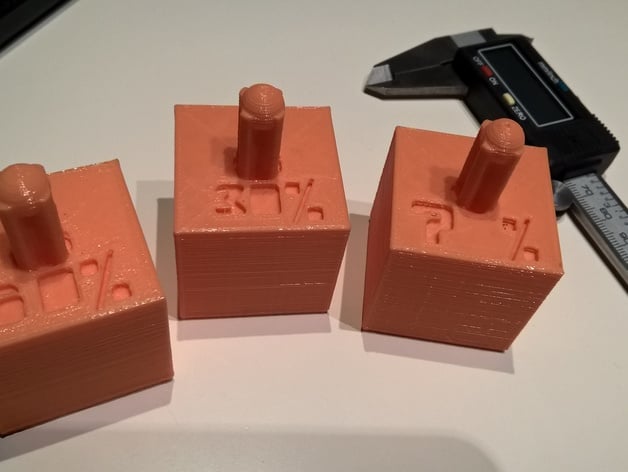
Infill and Density
thingiverse
This activity has two main goals: to become familiar with 3D printing parameters such as time, material consumption, and the ability to modify physical properties in printed objects. The second goal is to experiment with physics, specifically density and buoyancy, by applying the Archimedes principle. To achieve these objectives, we will print three identical cubes with different infill values. Two of them have a known infill value indicated on their top face, but it's up to you to determine the infill percentage of the third cube, which will display "? %" on its top face. Students must guess the actual infill percentage used. Print Settings Printer Brand: RepRap Printer: PowerCode Rafts: No Supports: No Resolution: 0.248 Infill: variable Notes: Objects were printed in PLA at a layer thickness of 0.248, but this parameter is not crucial for this activity. How I Designed This I designed the objects using #Sketchup Make (free), as I have basic skills and aimed for simplicity, since design itself is not the focus of this activity. I created three identical cubes with the only difference being the text on their top sides, indicating either "30%", "60%" or "? %". A vertical rod was added to hold the cubes upright while in water, but it might be tricky to print due to its small section size. To alleviate this issue, a cylindrical prism of the same height was included for simultaneous printing and allowing time for the previous layer's cooling. Activity Document (infill and density.pdf) was created with Excel. Project: Print Infill & Object Density Objectives: * Become familiar with key 3D printing parameters, mainly infill. * Understand how to modify physical properties of 3D printed objects. * Science: Apply Archimedes principle. Audiences: * Any 3D printing student (beginner level). * Any school student who has studied Archimedes principle. Preparation * Students will need access to computers and a 3D printer in the classroom. * Load "30 infill cube.stl" into the software, select 30% infill, note predicted print time and material used. Dimensions should be similar to those indicated by CURA. * Print the cube and record how long it took. Repeat steps 2-4 for the "60 infill cube.stl", selecting 60% infill. Step 5: Load "Unknown Infill Cube.stl", select your desired % infill (my suggestion is less than 60%, to save time, filament, and avoid printing an object that sinks in water). Note predicted print time and material used. Dimensions should be similar to those indicated by CURA. Print the cube and record how long it took. Part 2: Buoyancy Test (Archimedes Principle) Take a glass of water where each cube can fit. Hold the first cube by its tip, slowly dip it in the water until it floats, without applying vertical force. Note the wet height (how many mm stay in the water). If preferred, measure dry height and subtract from total edge height. Repeat with the 60% cube and the unknown infill cube. Plot on a chart the data of the known cubes: infill % on the X axis and wet height on the Y axis. Draw a straight line connecting the two points. Mark the wet height of the unknown % cube on the Y axis. Move horizontally to the right until it intersects the previous line, then go down vertically to the X axis and note the infill percentage. Confirm that it is similar to the actual one defined in CURA. Results: * At the end of this project, each group should have: + 3 3D printed objects + Filled-in Activity sheet + Comprehension on how infill and other parameters affect printing time, material usage, printing cost, object density, weight, etc. + Comprehension of Archimedes principle.
With this file you will be able to print Infill and Density with your 3D printer. Click on the button and save the file on your computer to work, edit or customize your design. You can also find more 3D designs for printers on Infill and Density.
